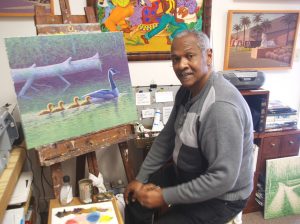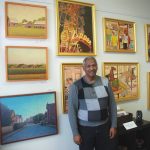
BERLIN — After 50 years of being one of the most respected and sought after artists on the shore, Patrick Henry says people still ask him when he’s going to get a “real job.”
It’s one of the many things these days that makes him flash that country mile-long smile that is as synonymous with his name as his striking paintings of some of the region’s most aesthetically pleasing places and things are.
“I guess some people just don’t get what it is that I do, and they wonder how I could possibly survive doing it for as long as I have here on the shore,” he said with a slight-chuckle. “Sometimes I wonder how it all happened too.”
Artists Listens To Bible While Painting
Patrick Henry is a humble, God-fearing man. So much so, when he paints he listens to the Bible on CD. “Some days I listen to smooth jazz,” said Henry, “but listening to the Bible helps me keep out the negative energy that can get in the way of my work.”
Beside him while he paints is an old beat-up metal box that he’s had since he started painting five decades ago that holds his paints and brushes. Surrounding him on the walls of his workspace in Berlin is a sort of “greatest hits” of his long career.
Dozens of grandiose and breathtaking paintings of landscapes, hotrod cars, and images of the Eastern Shore, and Berlin in particular, that we have all seen perhaps a thousand times, and still and somehow never managed to see them the way they appear in a Patrick Henry painting. He points to, two small pictures, each paintings of a vase with flowers in them. The paintings are noticeably old, and they are almost squashed out of view by the larger and flashier works on the walls. It’s interesting that they are about eye-level and placed right by the door, making it obvious that Henry wants to cast a gaze on them each time he leaves this room. They seem almost out of place, until Henry explains why they are there.
“These were the first paintings I ever did at my grandmother’s house,” he said. “They were the old paint by numbers pictures.”
Since Henry painted those pictures, he’s sold over 1,000 pieces. He worked construction and maintenance jobs while living with his mother in the early part of his artistic life when art was just his passion. But, by 1983, Henry made art his full-time career being commissioned to paint works that would be featured in many resort hotels in Ocean City and at places throughout the shore. From there, he’s grown his client base and diversified his portfolio by staying true to his signature style while simultaneously pushing the boundaries of what art lovers expect of a “Pat Henry” painting to look like and how it makes them feel. Simply put, while his paintings are all different, there’s a stylistic common thread that ties them all together.
“I think many artists tap out their market because they don’t push themselves to try new things,” he said. “I have never been okay with doing the same thing over and over.”
His success may have started as a “local-boy-done-good” kind of thing, even if some locals don’t understand his craft or how he keeps his lights on. As a young man, he worked his way through the local public school system, being amongst the group of African American students who broke the color barrier during integration at the historically all-white schools.
Yet, Patrick Henry doesn’t waste too much time talking about the fact that he’s not just a fantastic artist, but that he’s a fantastic African American artist living on the Eastern Shore.
“I’ve never spent too much of my time thinking about race,” he recalls. “I believe God wants us to be joyful, and I will admit, in the African American community, there is often a subtle sense of ‘I can only do so much.’ As an artist, you have to fight through those moments of self-doubt that can turn into self-sabotage and you just keep moving forward.”
One of Henry’s dreams was to get his work shown in a museum, and in 2007 that dream became a reality.
A gallery of Henry’s works were featured at the Reginald F. Lewis Museum of Maryland African American History and Culture in Baltimore.
While that moment was a dream come true for Henry, that high was quickly followed by a very tough period that was caused by the Great Recession the following year.
People lost their jobs, their homes, and their life savings. The clientele of people who were buying Henry’s acclaimed artworks, quickly dried up.
“I thought, what in the world am I going to do?,” he remembers. “Who is going to hire a man in his 60’s? But, I kept at it, and borrowed some money from my wife, and kept painting. This year, I finally feel like the economy is getting to a point where people are starting to invest in art again.”
We Are “Survivors” On The Shore
An artist’s life is not easy, especially on the Eastern Shore, but Henry says it can be incredibly rewarding. Earlier this week, Henry found himself flashing that trademark smile for a picture with some fans who were purchasing an original work: a simple, yet stunning painting of a group of deer grazing in an open meadow. He thanked the couple, who were admittedly huge fans of Henry’s work.
“Meeting people like that, who appreciate the work that I do, is the type of thing that keeps me going,” he says.
Patrick Henry could have left the Eastern Shore and probably had an easier go of “making it” as an artist, but he says he never seriously considered it. His life is his wife, his daughter, his faith and his paintings. In a way, a Patrick Henry painting can show you the beauty of the very streets you live on, and there’s an elegant simplicity to his interpretation of things that we have seen many times before.
“We are all survivors on the Eastern Shore,” he says. “Life here often feels like surviving in a very beautiful place.”
Perhaps Patrick Henry’s greatest God given gift is the ability to so aptly capture these images of moments that exist right in front of us and seemingly all around us, as we hurry along in the ongoing quest of our own coastal survival.
When I mention this to Patrick Henry, he just smiles, and says, “you want to see the new series of paintings I’m finishing up?”
I nod my head yes, and we walk back through his museum-like workspace, as he gives me a sneak peek of the next Patrick Henry works that could possibly be hanging on someone’s wall for the next 50 years.

